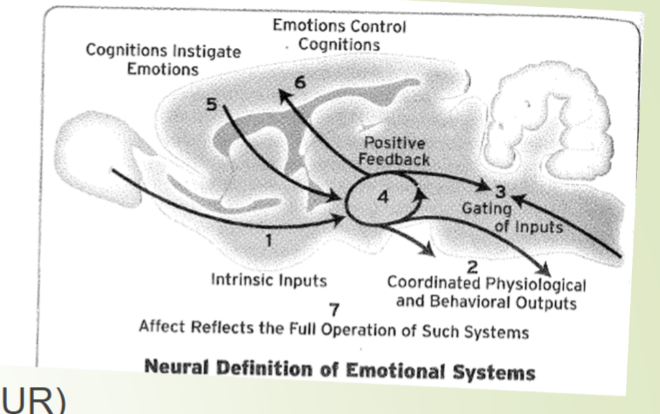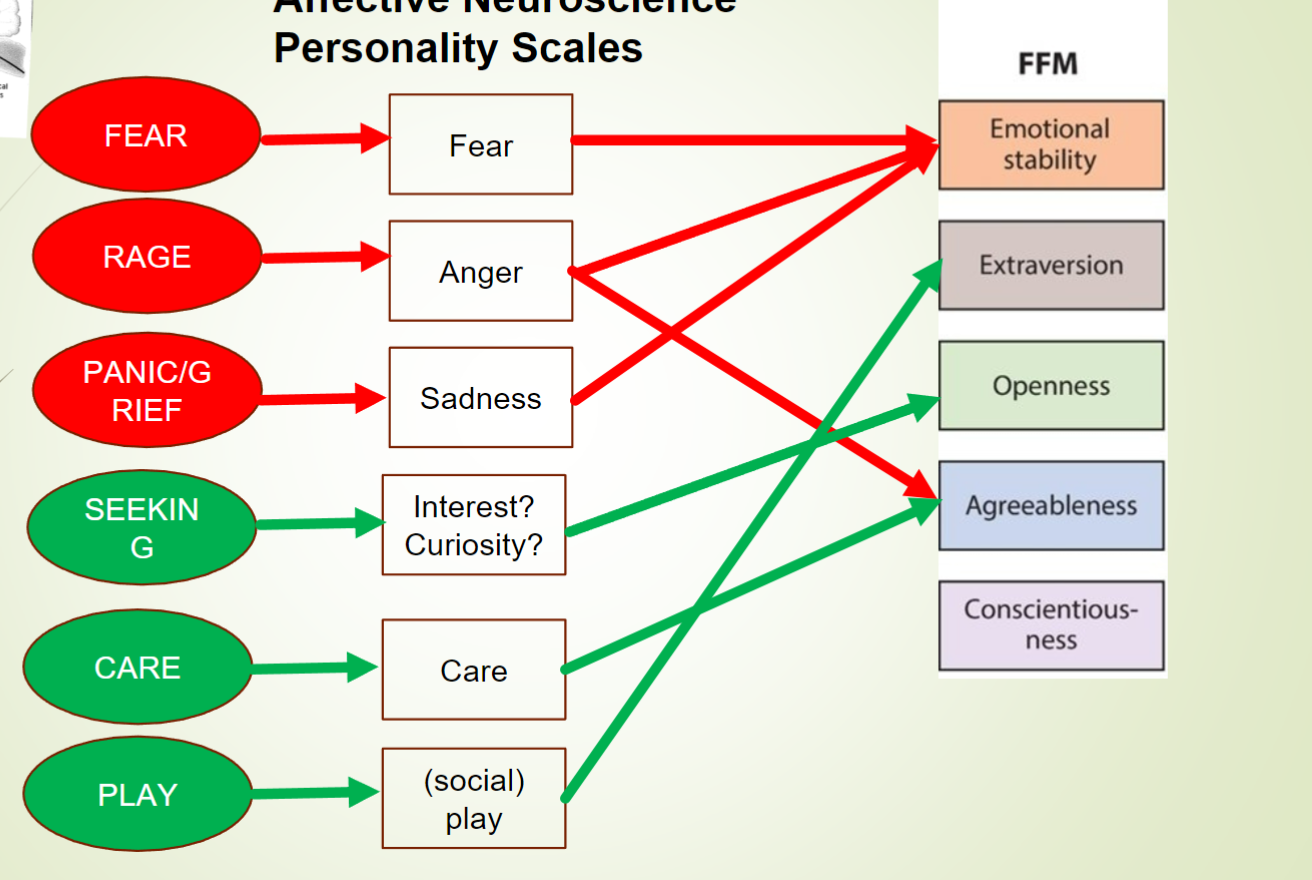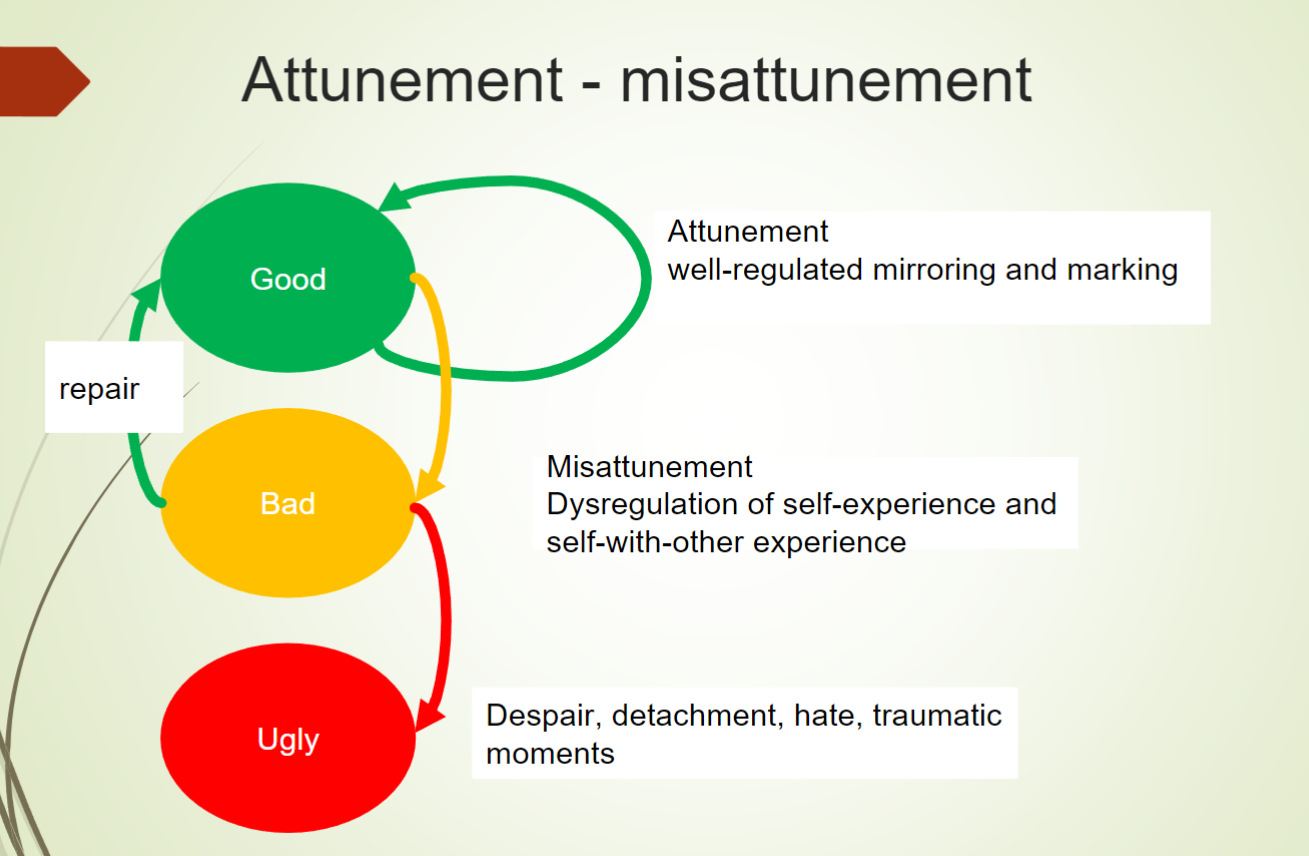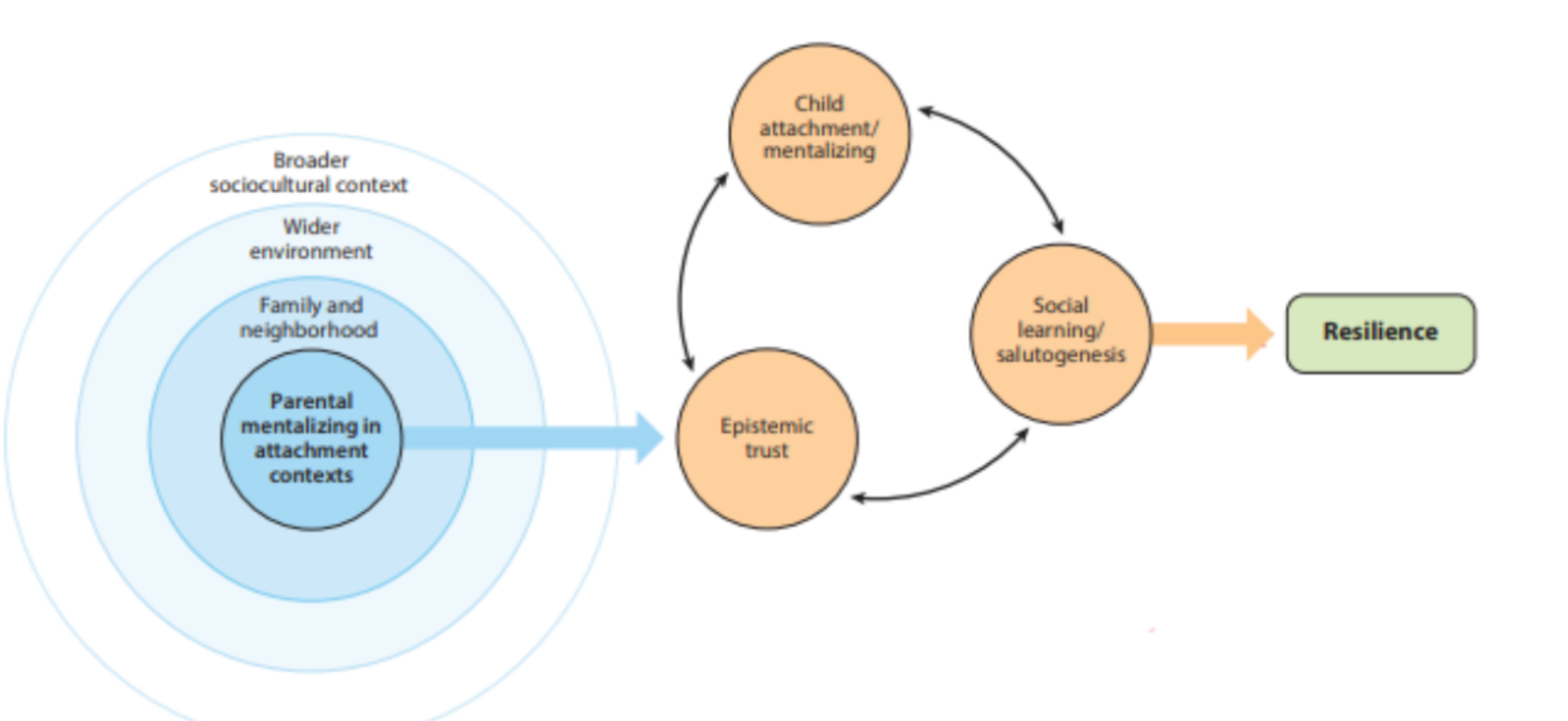Lecture 6 and online videos
5.0(1)
Card Sorting
1/40
There's no tags or description
Looks like no tags are added yet.
Study Analytics
Name | Mastery | Learn | Test | Matching | Spaced |
|---|
No study sessions yet.
41 Terms
1
New cards
The seeking system
Provides animals with “energy” (i.e., enthusiasm) to explore the environment. This is necessary to find mating partners as well as food to nourish both brain and body.
2
New cards
Affective experience of the seeking system
High: interest, euphoria
Low: disinterest/lack of motivation, anhedonia and apathy
Low: disinterest/lack of motivation, anhedonia and apathy
3
New cards
Possible clinical problems of the seeking system?
High -> manic states, drugs of abuse (e.g. cocaïne)
Low -> anhedonic, depressed, detached states
\
Note: seeking needs to be accompanied by something else in order to get satisfaction from it
Low -> anhedonic, depressed, detached states
\
Note: seeking needs to be accompanied by something else in order to get satisfaction from it
4
New cards
Fear system
promotes the avoidance dangerous situations and to carefully monitor the safety of environments
5
New cards
Affective experience of the fear system
High: Fight/Flight (high SEEKING) or Freeze (low SEEKING), terror Low: safe (to explore) - recklessness?
6
New cards
Possible clinical problems of the fear system?
High -> anxiety disorders, cluster C, PTSS, etc.
Low -> psychopathy?, Risk-taking
Low -> psychopathy?, Risk-taking
7
New cards
Rage system
observed when animals are in need to defend themselves (when a predator is closing in),
but also in situations of frustration, when an expected reward is absent, or being enclosed in a small space.
but also in situations of frustration, when an expected reward is absent, or being enclosed in a small space.
8
New cards
Affective experience of the rage system
High: irritation - exploding
Low: trusting - naivety?
Low: trusting - naivety?
9
New cards
Possible clinical problems of the rage system?
High -> intermittent explosive disorder, oppositional defiant disorder, narcissistic rage, etc.
Low -> lack of assertion (e.g. in depressions or dependent, avoidant PD)
Low -> lack of assertion (e.g. in depressions or dependent, avoidant PD)
10
New cards
The lust system
Of importance for procreation. In many mammals, it also appears to serve social functions (e.g. bonobo’s).
11
New cards
Affective experience of the lust system?
High: feeling some attraction - orgasm
Low: low interest - asexuality
Low: low interest - asexuality
12
New cards
Possible clinical problems of the lust system?
High -> Problems concerning problematic sexual behaviours
Low -> problems concerning impotence, lack of pleasure, etc.
Low -> problems concerning impotence, lack of pleasure, etc.
13
New cards
Care system
helps assure that the young children grow into adults and themselves can have families. In social groups this extends to non-family members.
14
New cards
Affective experience of the care system?
High: tenderness - parental love \n Low: carelessness - detachment
15
New cards
Possible clinical problems of the care system?
High -> self-sacrifice?
Low -> anti-social features?, parental failures?, postnatal depression?
Low -> anti-social features?, parental failures?, postnatal depression?
16
New cards
Panic/grief (attachment) system
Reflects separation distress and signals a situation of having lost contact with an important person or being lost in the environment.
For mammals and avians, separation from a caregiver or another important person triggers a distress reaction leading to distress vocalization (crying) to reunite with a partner or a parent.
For mammals and avians, separation from a caregiver or another important person triggers a distress reaction leading to distress vocalization (crying) to reunite with a partner or a parent.
17
New cards
Affective experience of the attachment system?
High: a longing or loneliness -- PANIC (high SEEKING) or GRIEF(low SEEKING)
Low: safety/exploring
Low: safety/exploring
18
New cards
Possible clinical problems of the attachment system?
High -> separation anxiety, trauma, borderline states, etc.
Low -> schizoid, detached states, maybe in psychopathy
Low -> schizoid, detached states, maybe in psychopathy
19
New cards
The play system
is inherent, especially in young animals. Such behaviour is important to learn social competencies and motoric skills.
Play-deprived animals will play more after
This also helps to get better in complex social groups when being an adult. Via play, friendships emerge. Humans in particular play a lot with symbols and ‘signifiers’, for example in humor.
\
Play is the first system to shut off in serious situations
Play-deprived animals will play more after
This also helps to get better in complex social groups when being an adult. Via play, friendships emerge. Humans in particular play a lot with symbols and ‘signifiers’, for example in humor.
\
Play is the first system to shut off in serious situations
20
New cards
Affective experience of the play system
High: friendly joy, comradery, tickling -- bursting in laughter, playfighting
Low: satiety or quietness --> boredom, loneliness
Low: satiety or quietness --> boredom, loneliness
21
New cards
Possible clinical problems of the play system?
High -> difficulty concentrating on routinetasks or overly structured situations, ADHD?
Low -> Obsessive patterns, joylessness, depressed personality?
Low -> Obsessive patterns, joylessness, depressed personality?
22
New cards
Properties of emotional systems
Once activated, they remain active for a little bit (if you get startled you won’t immediately go “back to normal”)
Colour the world (if you’re scared, you’re more inclined to find a safe place)
Shape the movements of the world
Colour the world (if you’re scared, you’re more inclined to find a safe place)
Shape the movements of the world
23
New cards

Neural properties of emotional systems
1. Intrinsic inputs (US) (loud noise)
2. Coordinated physiological and behavioural outputs (UR) (fear activates certain bodily movements)
3. Gating of inputs (CS and CR) (Conditioning)
4. Positive feedback (including auto-activation) (Being jumpier for the next hour)
5. Top-down influence (memories can trigger emotions)
6. Bottom-up influence (emotions can trigger memories)
7. Affect reflects the full operation of such processes (the full process)
24
New cards
Why are forms of vitality used as a concept?
It’s an attempt at conceptualizing the earliest experiential world of infants (moving, being moved by others)
25
New cards
Forms of vitality
Patterns of arousal that are associated with certain sensory experiences AND movements. (playing peek-a-boo with a baby, comforting a baby)
They are generally cross-modal; that is we do not experience them only in vision or hearing, but in any modality of sensory experience.
They translate between modalities; hence music and dance, poetry and being ‘touched’ are intrinsically related.
They are generally cross-modal; that is we do not experience them only in vision or hearing, but in any modality of sensory experience.
They translate between modalities; hence music and dance, poetry and being ‘touched’ are intrinsically related.
26
New cards
What are vitality forms perceived as
Vitality forms are perceived as wholes. They are Gestalten originating from five components: movement, force, temporal contour, space, and directionality/intentionality
27
New cards
Why are vitality forms not emotions?
They are structures of dynamic behaviour, which can contain emotions as well as fantasies, streams of thoughts, desires, and so on
28
New cards
What things are forms of vitality?
1. Physical touch
2. our voice/ eyes
3. Via that also mirror-neurons are affected; so we literally mirror the movement of the other.
4. symbols
29
New cards
Other animals - why do we have similarities with them?
* Evolved from common ancestors
* Provide models for what we share with them that don't have the kind of symbolic structures we live in
* Gives glimpses of non-cultural aspects of humans
30
New cards
What are we already experiencing before we have consciousness and a sense of self?
bodily movements and sensations
31
New cards
mentalization
Mentalization refers to the capacity to use, feel and reason from the assumption of agency in oneself and in others
\
We are born with multiple systems that teach us how to mentalize: do not know this from birth
\
We are born with multiple systems that teach us how to mentalize: do not know this from birth
32
New cards
epistemic trust
Epistemic trust refers to the reliance or confidence that an individual places in another person's knowledge, expertise, or information. It is the trust we have in someone's ability to provide accurate and reliable information or insights about a particular subject or domain.
\
However: epistemic trust is not the default mode of functioning and can be blocked \n and failing due to many context circumstances or development problems.
\
However: epistemic trust is not the default mode of functioning and can be blocked \n and failing due to many context circumstances or development problems.
33
New cards

Explain this
Ok
34
New cards
Regulation of forms of vitality and affect
Parents can use different ways to up- or downregulate the states of affect that the child is in
\
This gives rise to all kinds of vital experiences of “embodied being-with-another”
\
This gives rise to all kinds of vital experiences of “embodied being-with-another”
35
New cards
Mirroring
Refers to aspects of sameness in the reaction of the parent to the child (when the child smiles, you smile). this is also called **attunement**
Complete mirroring: baby does one thing, cg does the exact same thing
Over time, we do different mirroring (when the baby smiles, you say happy words) so the baby has an easier time differentiating between self and other
Complete mirroring: baby does one thing, cg does the exact same thing
Over time, we do different mirroring (when the baby smiles, you say happy words) so the baby has an easier time differentiating between self and other
36
New cards
Marking
Refers to differentiation in response to the child
(child does a voice that goes upwards, parent does a voice that go downwards)
Or for example soothing words in response to crying
\
If the difference between what the child and the parent does, the connection might be lost; this is called a **misattuned response**
(child does a voice that goes upwards, parent does a voice that go downwards)
Or for example soothing words in response to crying
\
If the difference between what the child and the parent does, the connection might be lost; this is called a **misattuned response**
37
New cards

Cycle of attunement
Bad attunement can lead to dysregulation of self-experience and self-with-other experience - but you can repair this and go back to good attunement
Ugly attunement: despair, detachment, hate, traumatic moments
Ugly attunement: despair, detachment, hate, traumatic moments
38
New cards
Correlations between primary emotional systems and 5-Factor Model
High seeking = high openness to experience
High play = higher extroversion
High care and low anger = high agreeableness
All negative emotions = Neuroiticism
\
Associations with conscientiousness are weaker because most mammals do not have conscientiousness
High play = higher extroversion
High care and low anger = high agreeableness
All negative emotions = Neuroiticism
\
Associations with conscientiousness are weaker because most mammals do not have conscientiousness
39
New cards
How does the environment control genetics (through epigenetics?
The epigenome determines what genes are turned on or off based on the environment
40
New cards
What are the 4 main assumptions of mentalization?
* We are predisposed to learning mentalization evolutionarily
* Considerable environmental input is needed to develop full capacity for mentalizing
* Mentalizing is a transdiagnostic and transtheoretical concept
* Mentalizing is a factor commonly associated with recovery in a range of psychotherapies
* Considerable environmental input is needed to develop full capacity for mentalizing
* Mentalizing is a transdiagnostic and transtheoretical concept
* Mentalizing is a factor commonly associated with recovery in a range of psychotherapies
41
New cards

Social-evolutionary communicative model
The mentalizing capacity of the parents is influenced by a wide range of things that influence child development (socioeconomic status)
These attachments influence the development of epistemic trust in the child, which starts a virtuous cycle influenced by social learning and salutogenesis (capacity to benefit from positive environmental influences)
Using secure attachment strategies when faced with
These attachments influence the development of epistemic trust in the child, which starts a virtuous cycle influenced by social learning and salutogenesis (capacity to benefit from positive environmental influences)
Using secure attachment strategies when faced with